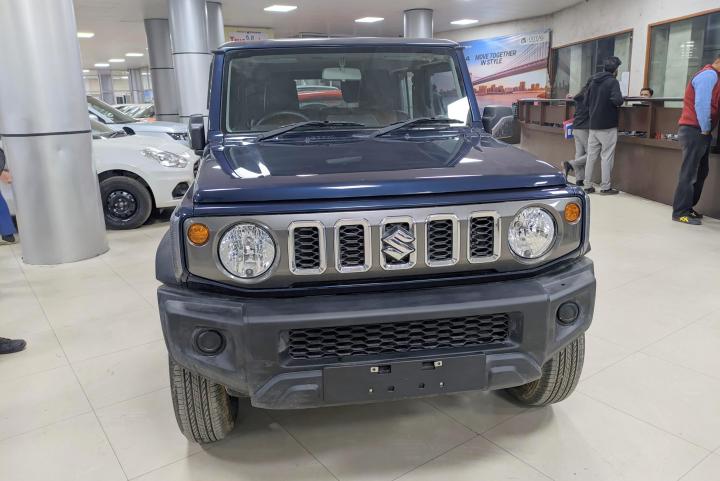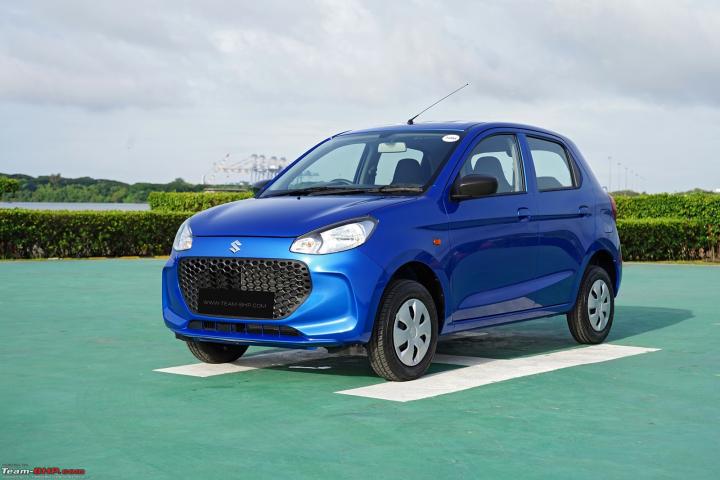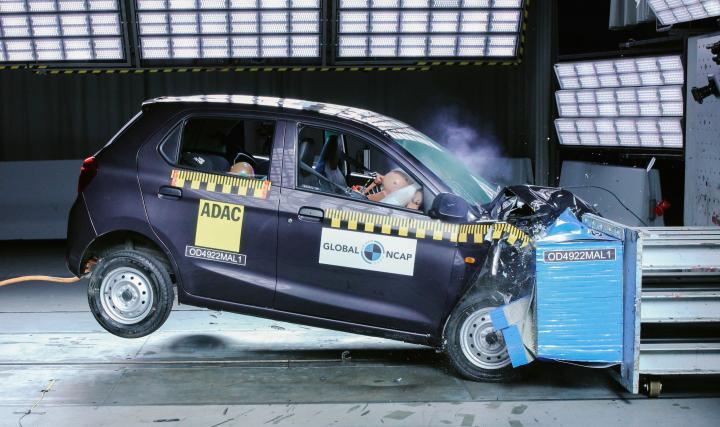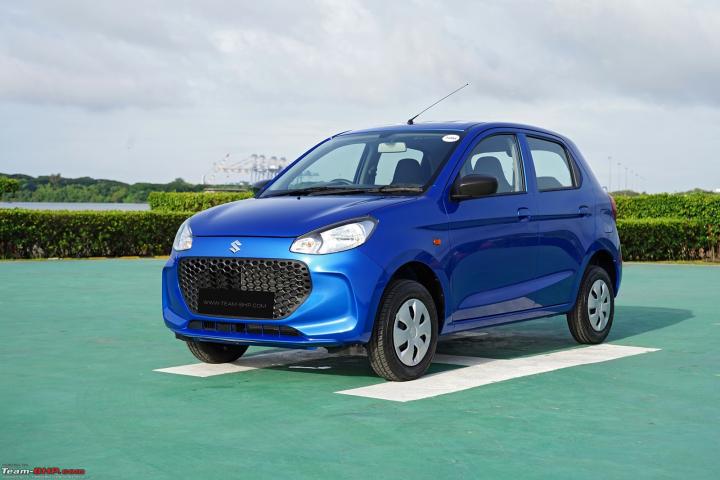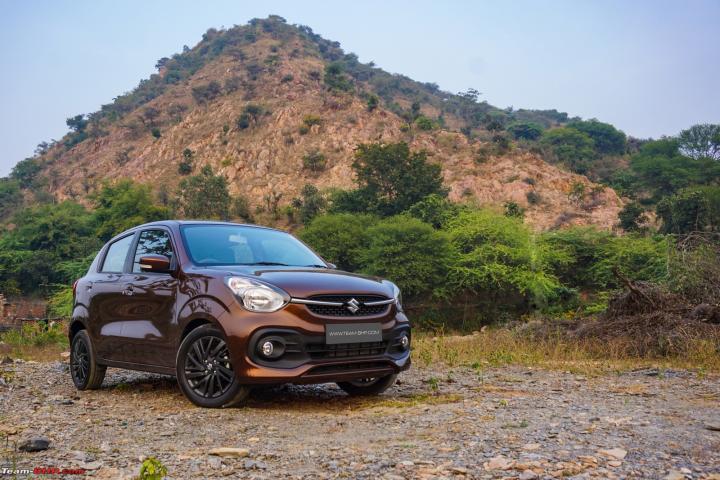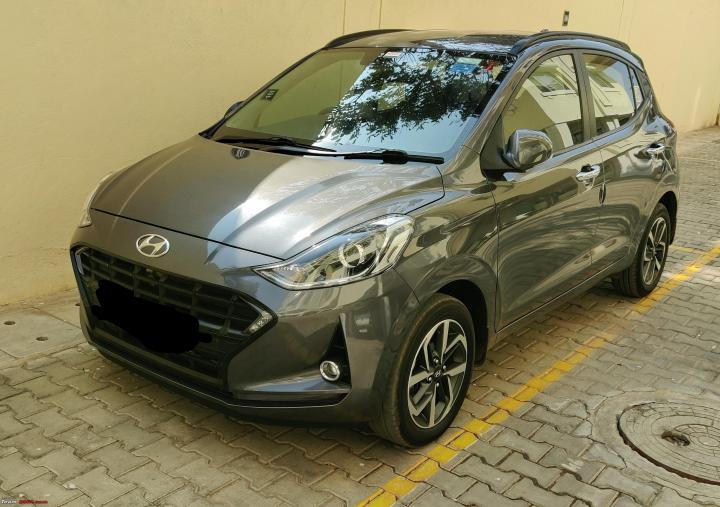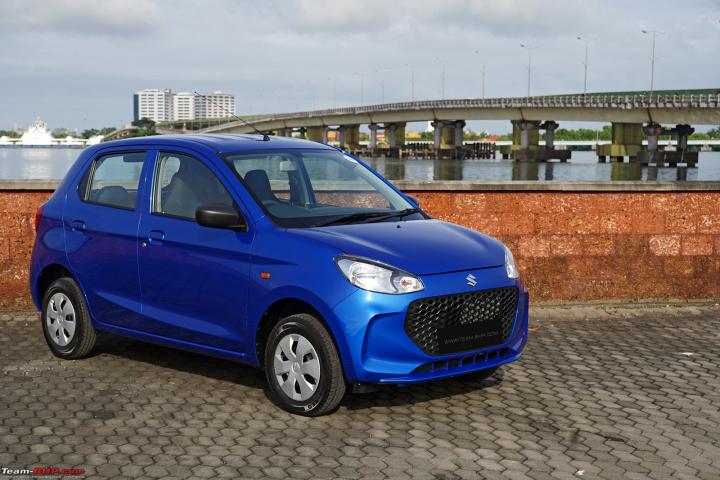News
1.14L km with my Maruti Alto K10: An emotional farewell note
The world of analogue simplicity has ended, and the race to digital artificial intelligence has gained traction.
BHPian sidindica recently shared this with other enthusiasts.
1,14,400 kms and the last goodbye
Its not easy to part ways with your first car, specially if the car had an emotional connection with defining your responsibilities. But, eventually, all good things come to an end, and its time to move on.
With my cousin moved on to the states for the next few years, the car had to go. With 4 years of shelf life left, it made sense to sell within the family, and eventually the new owner is his brother in law only. With newfound traditions, the baton moves on.
Maruti created a masterpiece, it was an accidental mistake. The mistake reaped rewards, and the amount of fun we had, very few cars could match. All companies have deviated from their core principles, including Maruti, in a race to create carputers.
The world of analogue simplicity has ended, and the race to digital artificial intelligence has gained traction.
But, its not every second, minute, hour, day, week, month, year or a decade we live to create automotive stories. Car stories are meant to be cherished, for life.
We started it all. Time to bid one final goodbye, because, India ki chal padi.
Read BHPian comments for more insights and information.
- Tags:
- Indian
- Maruti Alto K10
News
Upgraded from an Alto K10 to Maruti Jimny: Observations after 800 km
It is spacious, comfortable and easy to drive. The ride over potholes is comfortable as compared to the Alto and Kia Sonet.
BHPian chheringpal recently shared this with other enthusiasts.
Happy Member of the Jimny Club
Finally, after drooling over the 3-door Jimny, excited after Jimny India launch confirmation and sad over its initial pricing, the Gods above and decision-makers at MS had some mercy over people like me and brought out the price-drop/year-end discount. The discount made me think whether I should buy it or not.
My ex-boss was constantly pushing me to buy the Jimny, since a few of his friends too bought it after the price drop. He has been long saying that we will go for a snow drive in my Jimny when it snows this winter in Shimla. So after a long wait and dilly-dallying, I finally paid a visit to the Nexa showroom in Shimla and finalised the Zeta MT.
Jimny (Nexa Blue-MT) was delivered on 26th Dec and took a small night ride with my spouse and brother for fuelling up. Finally got the chance to take it to my hometown a few days later and here are some of my observations of the Jimny after about 800 Km of driving.
- Coming from a 2016 Alto K10, Jimny is spacious, comfortable, and easy to drive. I’m enjoying the drive.
- Being a compact SUV, not much of a hassle to drive around Shimla where space is always a constraint.
- Turning radius is large but if you plan well, you can manoeuvre it quite easily. In my hometown, I did the same turns in a single go in Jimny as I used to do in Alto K10. You need to consciously plan your turn and go about it.
- The ride over potholes is comfortable as compared to Alto and Sonet, but over speed bumps at slightly higher speeds the rear end feels like it swerves a little bit.
- I got a fuel efficiency of 15.6 KMPL for tank-to-tank fuelling for the Shimla-Bilaspur-Keylong-Kullu stretch. During the stretch from Shimla to Bilaspur I got a fuel efficiency of 20 KMPL (mostly downhill) but for Kullu to Keylong stretch, I got a fuel efficiency of 11.5 KMPL.
- Engine is powerful as compared to Alto K10, as I could take uphill turns even in 3rd gear till Manali. After Manali, I had to do similar turns in either 2nd or 1st gear. At high altitudes, it did struggle a bit during overtaking. But between Shimla-Kullu didn’t face any such issue as I usually avoid quick overtaking.
- My colleague finds the rear seat comfortable (city rides only) as the seats are upright and big windows don’t make him feel claustrophobic like the ones of the i20 do.
- Lastly, everyone near my office talks about the Jimny whenever I take it to the office. Yesterday one of my colleagues' driver brought his other driver friend to show the Jimny inside out.
- Jimny surely brings out the smile in everyone who is in its presence.
Overall, I am quite happy with the decision to become a Jimny owner.
Now waiting for snowfall in Shimla to try out snow driving with my Ex-boss and colleagues.
God, please let it snow this year!

Check out BHPian comments for more insights and information.
- Tags:
- Indian
- Maruti
- Jimny
- Alto K10
- Maruti Alto K10
News
Why are Entry-level cars falling out of favour?
There is a big section of Indian society who are restricted to two wheelers only because of budget constraints and many of them migrate to entry level cars as and when possible.
BHPian cludflare recently shared this with other enthusiasts.
Buying a first car can be a very difficult discussion for many. With India shining, most of us would end up owning at least 4 to 5 cars in our lifetime if not more. But the first one is always special. There are different opinions that people hold around first cars – some believe a used car is the best way to get your hands accustomed and then move to a new one, some believe that in the new age one can directly own an automatic and skip the manual world completely, some do not want to compromise on safety these days at all, while for many it’s a pure decision of affordability.
There is a big section of Indian society who are restricted to two wheelers only because of budget constraints and many of them migrate to entry level cars as and when possible. This is one space that I have a particular interest in. I live in Bangalore and often notice that there is an increasing drop in the number of Altos and Celerios on the road, which is understandable with Bangalore having the highest per capita income in the country. But unlike the big cities, this segment is extremely important for a massive part of India. For many of us, the first car was always an entry level car which might be changing now.
Maruti Suzuki’s chairman recently shared his view in their half yearly press conference about the significant drop-in entry-level car-space.
The objective of this post is to have some discussion around the lack of options and OEMs disappearing from this space and second, the importance of safety features in the segment.
Even if MSIL’s sales numbers from this segment remain high, this is not a value segment. I have deep respect for Maruti Suzuki to continue to focus on the demography that buys their first car based on affordability. Decade over decade, Maruti has ensured that the Indian customer is not running out of options at all non-premium price points. While others like Hyundai chose to fold, Maruti holds the fort. It was extremely sad to see first the Eon followed by the Santro coming under the axe. The cheapest Hyundai (Nios - Era) now costs 7 lakhs on road. On the other hand, Maruti still offers the lower middle class buyer the option to chose from Alto, Celerio, Wagon R and even the Ignis priced aggressively. Also notable mentions are the Kwid and Tiago still being around.
I understand that with the commodity costs on the up and the tax treatment for foreign players (excluding Koreans) makes the business less viable in this segment. That makes me think about the mandate of having 6 airbags for all cars. I do believe safety is very important aspect of a car, and it should be one of the top priorities for all car buyers, if you can afford it. But there are millions of Indians who will want to upgrade to an entry level hatch from their scooters – don’t bump in their costs.
Kudos to Tata Motors for raising our awareness towards safety, but hey – don’t mock S-Presso in your social handle for 0 stars. You are not the one offering a car at 4 lakh ex-showroom.
Here's what BHPian The_Rationalist had to say on the matter:
You are simply nitpicking on TATA. The cheapest car, Alto costs ₹4.6 lakh in Kerala, Tiago costs ₹6.6 lakh. In EMI terms it’s around ₹4000. There will be very minuscule percentage of people who can afford a Alto but not a Tiago! The sales of the cheapest 3 cars in India is <5% of total sales! So the percentage who can’t afford a Tiago, yet able to afford an Alto will be less than 5% of car buyers.
Let us assume a person wants to buy a car. I bought my first car 20 years back, it was an used Zen, I drove it for 14 years. Mind you there were less options then. Now for the cost of an Alto you can get lot of good used cars. So, it is not that cost of entry level cars is high, the country has grown up in income and that is reflected in car sales. My first car was bought for ₹3 lakh in 2002, so with regard to inflation the car prices has not grown that much. ₹3 lakh in inflation terms would be ₹11 lakh now. That means while the former could only afford me a Zen, that too a used one, now for same inflation adjusted money I can almost get a new Virtus/Slavia! We can simply crib on imaginary issues, while the fact is entirely different.
Here's what BHPian Aakash118 had to say on the matter:
More than anything, it’s the decreasing aspirational value of cars like Alto & Celerio which is responsible for downfall of this segment. I know at least 3-4 people in my circle who bought their first car in the form of a used i10 or Ritz, learned driving on it and then directly upgraded to a Nexon or Creta. A new Alto or even Tiago is just not aspiring enough for them.
Here's what BHPian ninjatalli had to say on the matter:
Buying a car is a big jump for a lot of middle-class Indians; but for the same, the decision also focuses on maintenance costs. And with regards to that aspect, Maruti leaps ahead by a huge margin. In reality, the cost of ownership for a Maruti might not be very far from a Hyundai in the same segment, when serviced at regular service centers. But from a mindset, Maruti still screams as value-for-money for the average fellow on the road. And that also gets revalidated when one goes to an FNG or tries to sell an existing Maruti car.
I believe the likes of Hyundai, Tata and others have realized they can't fight this and have "shifted" their entry level segment range while focusing on other aspects (e.g. safety, gadgetry). Maruti would love to do so but the bottom of the pyramid is still a cash-cow for them (even if the margins are very low) and hence they have to make-do with whatever possible (e.g. limited safety features). I expect over time the old models (Alto, etc.) will be phased out eventually.
Here's what BHPian M_powerred had to say on the matter:
I believe its the easy availability of EMIs and loans. People with jobs can easily sign a few documents and add one more year to their loan tenure and get a car thats segment above. Hence everyone is going for it. Since the idea of having more than one EMIs is getting accepted by the younger earning population, from EMIs for the new iphone and a car feels mostly similar. So why not? Is the question of the new earners. I am not saying anyone is being financially irresponsible with their funds, because at the end YOLO...
Here's what BHPian rishi.roger had to say on the matter:
There is not a substantial difference between 5 lakh and 10 lakhs these days. If someone can purchase a 5 lakh car, buying a used or even a new 8-9 lakh car won't be very difficult. Thanks to the financing scheme provided by banks, and also a change in purchase mentality in modern Indian population (particularly those in Metro/Tier-1 and some Tier-2 cities).
Social media content also has a lot of influence on the youth.I think the puzzle could be solved further if one gets their hands on amount of cars that have been sold on loan, % of loan amount and age groups they're sold to.
I feel, A lot of people buying cars these days are youngsters, who don't mind the burden of EMIs as they see a bright future for Indian economy. They understand that for sure, they could get an Alto right now but soon enough they'll earn more and desire more - so why not put their money somewhere that's also slightly future proof in terms of meeting the desire/needs.
Read BHPian comments for more insights and information.
News
Spent 36,000 rupees on running repairs on my 11 year old Alto K10
It seems expensive at first but when you see the list, it was worth it. rather than wasting money behind a new car.
BHPian sidindica recently shared this with other enthusiasts.
Major Update | 11 years | 1,09,450 kms | Now called as systumm

Its been a long 8 years since this thread saw an update.
8 years. The world changed. The universe changed. People have changed. The country has changed. Analytics have changed. Analysts have changed. Summit has changed. Venues have changed. And above all, responsibilities have changed.
Today, September 8 2023. The car is now with me, for a few months (or maybe years?), as the family is in the states for their projects. A LOT has changed since then.
Throughout this 8 year tenure. the car continued to perform flawlessly, as a city runabout and daily drive. There was a gap in me seeing the car, and over the years, though most services were performed at authorized Maruti Suzuki workshops, the quality of service and customer centricity began to deteriorate. Age related issues crop up, but the car never got much of TLC simply because of time constraints or waning interest.

The car came to me on August 4 2023. it just looked OK, had its fair share of battle scars, but mechanically it needed attention, and that meant a hefty bill as well. My cousin agreed to this, since anyways he was out, it gave me enough time and space to begin to mechanically and cosmetically redo the car wherever required. Body was not an issue, but few dents...and many things needed attention.
I began to make a list of the priority problems to be attended to followed by the minor ones at the last stage.

Made my visit to Jhalak cars (the guy who does my Fiats) Noida and the following tasks were performed.
- The vehicle was having excessive vibrations. culprit was traced to the engine mount. Changed with MGP mount.
- Clutch had finished completely, travel was hard and pickup was missing. New clutch installed.
- Car was serviced with mobil 1 5W30 engine oil and MGP oil filter.
- Tailgate struts were conking off. New ones from Munjal showa installed.
- All 4 door window weatherstrips changed.
I went to a MGP store, kasthuri motors in Ghaziabad, and procured the following items which needed replacement or were missing.
- Full wheel caps. All broken, new ones procured.
- Both front fog lamps. Damaged due to age, water ingress and a stupid local LED bulb that was installed.
- Side waistline moulding (got after a lot of struggle from competent Ghazipur)
- Mudflaps (missing)
These were installed back at jhalak.
But many small things needed more attention.
- The AC was not working at times. and gas was leaking out. After much deliberation. I went to Kapoor AC service, located in my colony where I live (Mayur Vihar 2, Delhi), who is known for proper AC diagnostics and thats where the culprit was traced. He checked first the external pipes for leakage, which was not there. The cooling coil was out next, checked for leakage, it was given a go ahead (The coil was replaced 2 years back at Maruti). The compressor was the next to go under the knife, nothing came out. We finally opened the front bumper and it was the poor state of the AC condenser (bent fins, dents, damaged body etc) that leaked out the gas. Maruti's easy parts availability ensured the new condenser came within 30 minutes (Subros) and was installed. Full AC system was serviced and the problem was gone for good.
- New Suzuki valve stem vaps were installed from MGA.
- New Key ring from MGA was brought (leather)
- The wiper motor linkage was vibrating like hell. Procured the new one from a MGP store in Mayur Vihar phase 1 and installed at a workshop in my colony.
- New wipers installed (frameless).
- Finally, for the first time in 11 years, the day night IRVM was installed (first gen wagon R one procured from MGP store.
- Both side power window switches needed replacement. Replaced.
- New radio antenna. Old one had corroded.
- Speakers serviced and wiring made proper.
- Headlamp bulbs changed to stock ones (60/55w) which were there lying extra from my older Puntos.
- Removed all the extra wiring/non working relay/non functional horns and made the engine compartment neater.
I got the car washed and gave it very basic detailing after this, and finally the car was back on the road, with fresh new set of mechanicals, driving like a new car, good to keep for another many years without any hiccup.
The total damage to all this was close to Rs. 36000. It seems expensive at first but when you see the list, it was worth it. rather than wasting money behind a new car.
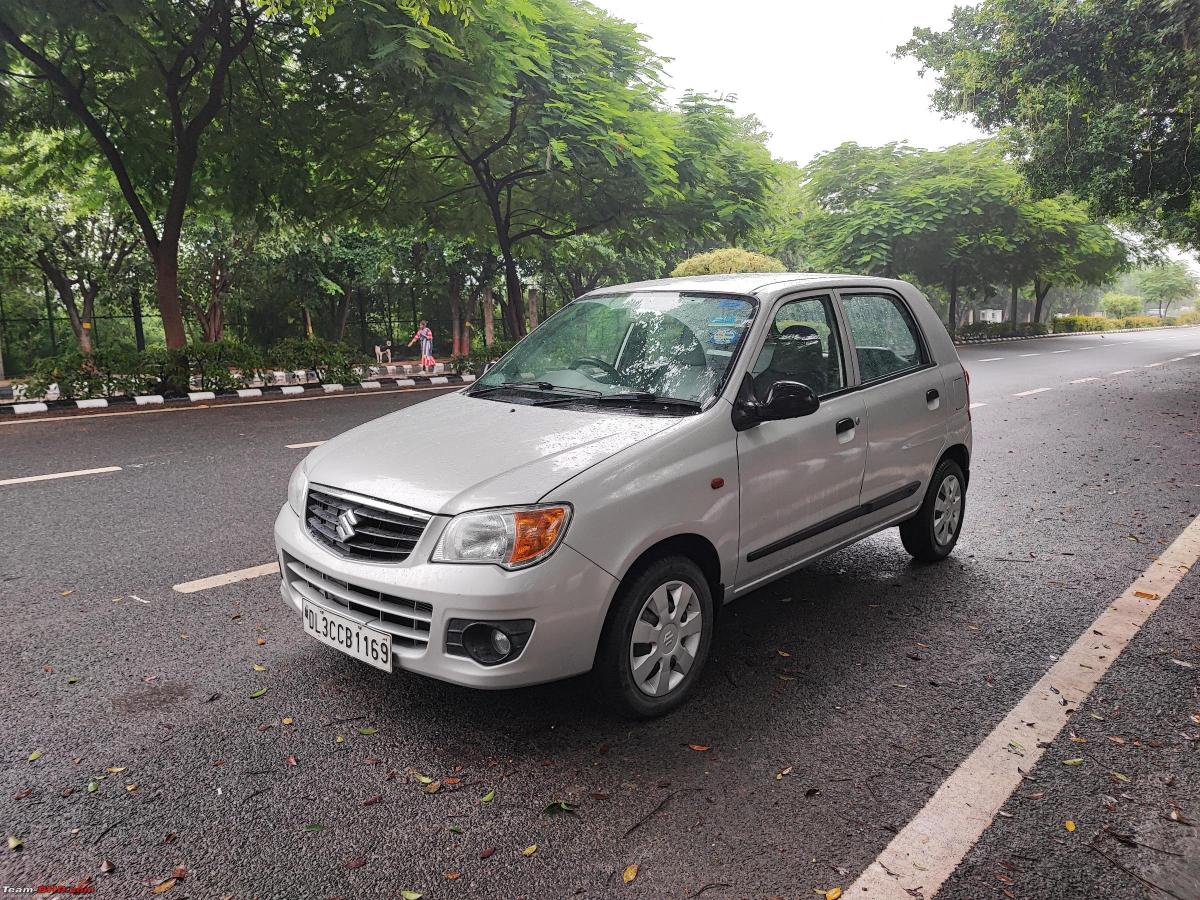
I drove the car for 1500 kms, and the car runs fresh, tight, with no rattles (took time to close them) and continues to be a fun daily car for local errands and grocery shopping.



Signing off with few pics clicked today. Eagle eyed readers will note the sports pedals from the Zen carbon, which I had lying with me for years, finally installed on the Alto, which I now call as #systumm. And no, it has nothing to do with Elvish Yadav winning the big boss. Lord Alto remains the original bigg boss.
Read BHPian comments for more insights and information.
- Tags:
- Indian
- Maruti Alto K10
News
A brand new hatchback on a 6L budget: Alto K10 vs Celerio vs Kwid
The Kwid looks light and good, while the WagonR is not aesthetically pleasing, but I believe it offers more interior space.
BHPian raptor_diwan recently shared this with other enthusiasts.
I am looking to buy a second car for city rides, mainly with an automatic transmission. My budget is 5 Lakhs, and I have checked the used car market, but I am not satisfied with the way they have been maintained. Now, I am slightly extending my budget to 6 Lakhs and planning to buy any one of these cars new with an automatic transmission.
I am confused between these three options. Personally, I am not happy with the way the Celerio and Alto look. They don't suit my body shape, and I feel they might appear too small when I sit in them. The Kwid looks light and good, while the WagonR is not aesthetically pleasing, but I believe it offers more interior space.
Is the Kwid more spacious than the WagonR? Can the Kwid provide better mileage than the WagonR? The WagonR AGS claims to have a mileage of 25, but even if it's 18, it's acceptable to me.
Here's what BHPian tharian had to say on the matter:
Let me help in terms of the WagonR query only. I have no idea about the Kwid , nor the new Celerio or Alto.
The new WagonR is a spacious car, I am sure it is bigger than the Kwid on the inside. It is the perfect car for city use because of the easy ingress/egress and being a small footprint car, it easy to drive. We have one at home since early last year which was bought as a replacement for an old Swift, for my father who is in his mid-70's and drives to work everyday. So I opted for the AMT 1.0 version knowing that is sufficient for his use.
Fast forward around 6000 kms and 18 months, except for some dents and scratches due to parking, the sheet metal is as good as a cola can, the car is perfect for him and as well as me to use it for short distances. More than enough space on the side, including a decent sized boot.
On the fuel efficiency front, the car has been giving a consistent 12 kmpl with AC in city use. So you can confidently ignore the advertised figures.
There is no wheel cladding or noise deadening in the car, it feels like I am driving a 800 in the 90's. Same with the shocks and add to that the hard MRF tyres, a pothole if not avoided, hits with an impact in the cabin and on passengers.
The AMT needs to get used to. Now I am used to letting go of the accelerator to shift gears and I don't let the ECU do that. It works out more comfortable and predictable this way. But I heard the AMT is better on the updated version of the car launched last year.
End of the day, I would recommend it as a family city car or for ageing parents.
Here's what BHPian AYP had to say on the matter:
Before I state my opinion, I'd like to let you know that none of these cars shall fit in your budget of 6L. The cheapest automatic in India is the Alto K10 VXI which costs 5.61L ex-showroom and should cost around a lakh more on road in Chennai. This is the car which shall allow you to stick the closest to your budget.
If budget is no bar, the WagonR is the best choice in the 1.2 guise though. The WagonR 1.2 ZXi AMT costs only about 30k more than the 1.0 VXi and is actually more fuel efficient. The extra features and the peppier engine shall be an added bonus. Kwid is a good car(and it offers a tachometer as standard) but the Kwid AMT does not have a manual mode unlike the other cars. A manual mode may come in handy during some tricky situations. Due to this omission in the Kwid, I'd personally avoid it.
Between the WagonR 1.0 and the Celerio 1.0, while you have stated the Celerio is not to your liking, it does come with a tachometer(if it matters to you) and a better instrument cluster with a mode modern design while costing you 15k less. The power window placement is an issue though.
Here's what BHPian bijims had to say on the matter:
Before I state my opinion, I'd like to let you know that none of these cars shall fit in your budget of 6L. The cheapest automatic in India is the Alto K10 VXI which costs 5.61L ex-showroom and should cost around a lakh more on road in Chennai. This is the car which shall allow you to stick the closest to your budget.
If budget is no bar, the WagonR is the best choice in the 1.2 guise though. The WagonR 1.2 ZXi AMT costs only about 30k more than the 1.0 VXi and is actually more fuel efficient. The extra features and the peppier engine shall be an added bonus. Kwid is a good car(and it offers a tachometer as standard) but the Kwid AMT does not have a manual mode unlike the other cars. A manual mode may come in handy during some tricky situations. Due to this omission in the Kwid, I'd personally avoid it.
Between the WagonR 1.0 and the Celerio 1.0, while you have stated the Celerio is not to your liking, it does come with a tachometer(if it matters to you) and a better instrument cluster with a mode modern design while costing you 15k less. The power window placement is an issue though.
Here's what BHPian mgastor2022grey had to say on the matter:
I will recommend to you the Kwid Climber AMT. There is one in my near family, and I got to drove it a couple times. My observations are:
- Good and spacious car, when compared to my friend's WagonR.
- A great looker, better than the WagonR.
- Though Mediocre interiors, they definitely feel upmarket and is safe by Renault standards.
- You might want a Renault badge over a Maruti Badge IMHO.
- Beautiful looking car, compared to the WagonR (I hate the tallboy design).
- Better high speed stability than the WagonR due to better aerodynamical phase.
If you are looking for other cars, will suggest you the Tata Tiago/Tigor. Amazing safety and best looking designs, both inside-out.
Read BHPian comments for more insights and information.
News
Maruti Alto K10 scores 2 stars in Global NCAP crash tests
The car scored 21.67 points for adult occupant safety and just 3.52 points for child occupant protection.
The Maruti Suzuki Alto K10 has been awarded a 2-star rating by Global NCAP. The car scored 21.67 points for adult occupant safety and just 3.52 points for child occupant protection.
In the frontal impact test, the Alto K10 offered good protection to the driver and passenger's head and neck. The driver's and passenger's knees showed marginal and weak protection, while their tibias showed marginal and adequate protection, respectively. The footwell area was rated as unstable, but the bodyshell was rated as stable.
The car offered good protection to the head and pelvis in the side impact test. Protection to the abdomen and chest was rated as adequate and weak, respectively. The side pole impact test was not performed as the car does not offer side airbags.
The child seat for the 3-year-old was not able to prevent excessive forward movement during the frontal impact test. The CRS for the 18-month-old offered good protection for the head and weak protection for the chest. The car was awarded zero points as it does not offer 3-point belts in all seating positions.
News
Maruti Alto K10 CNG launched at Rs. 5.95 lakh
The Maruti Alto K10 S-CNG is said to deliver a mileage of 33.85 km/kg.
Maruti Suzuki has launched a CNG variant of its popular entry-level hatchback, the Alto K10. It is available in VXI S-CNG trim priced at Rs 5,94,500 (ex-showroom).
The Alto K10 S-CNG is powered by a K-Series 1.0-litre engine that produces 56 BHP @ 5,300 rpm and 82.1 Nm @ 3,400 rpm when running on CNG. The engine is mated to a 5-speed manual gearbox. Maruti claims the car delivers a mileage of 33.85 km/kg.
Like all other S-CNG models in Maruti’s line-up, the new Alto K10 S-CNG features dual-interdependent ECUs. The suspension is also said to have been calibrated to the updated powertrain.
Maruti offers a total of 13 S-CNG models. These include the Alto, S-Presso, WagonR, Eeco, Celerio, Swift, Dzire, Ertiga, Baleno, XL6, Super Carry and Tour S.
- Tags:
- Indian
- Alto K10
- Maruti Alto K10
- CNG
News
2022 Maruti Alto K10 vs Renault Kwid vs Maruti Celerio
The 4-cylinder petrol gives the WagonR the best performance & refinement of any car listed here.

2022 Maruti Alto K10

Maruti Alto K10 Pros
- A much improved, well-rounded city car as compared to the outgoing generation
- Peppy performance with a healthy power-to-weight ratio
- Excellent fuel efficiency. ARAI figures: 24.90 km/l (AMT) and 24.39 km/l (MT)
- Convenient AMT available at a premium of Rs. 50,000 makes it the cheapest automatic car available in India
- Sufficient cabin space to accommodate four 6-footers
- Small dimensions, good visibility, light controls, AMT transmission & a tiny 4.5 m turning radius make it a great choice for city driving as well as first-time car buyers
- Good touchscreen ICE with Android Auto + Apple CarPlay + steering mounted controls
- Maruti's fuss-free ownership experience & widespread dealer network
Maruti Alto K10 Cons
- Significantly more expensive compared to the previous generation
- Narrow width makes it a strict 4-seater
- Basic ride quality. Feels wobbly over rough patches and can bottom out on when going over larger potholes
- Poor high-speed dynamics & NVH. Best driven at double-digit speeds
- Skinny low grip 145 mm tyres given the power on offer
- Missing essentials such as rear power windows, rear wiper/defogger, day/night IRVM, etc.
- Light, economy-grade build quality. Sibling S-Presso scored 0 stars in the GNCAP crash tests
- S-Presso offers a lot more at just ~15,000 more (greater space, larger wheels & tyres, body-coloured and electrically adjustable ORVMs, features like ESP with hill-hold (AMT)), etc.
Maruti Alto

Renault Kwid

Maruti Celerio

Maruti S-Presso

Maruti S-Presso Pros:
- Funky design stands out from the crowd
- Well-priced for what it offers
- Spacious cabin with enough room for four 6-footers, and easy ingress/egress too
- Fantastic engine & MT gearbox. Fun, driveable, rev-happy, fuel-efficient
- Optional AMT automatic available at an Rs. ~43,000 premium
- 180 mm of ground clearance & a tiny 4.5m turning radius aid practicality
- Boot has a practical layout. Rear seat does fold down when required
- Nice touchscreen ICE with Android Auto + Apple CarPlay + steering mounted controls
- Maruti's fuss-free ownership experiences & widespread dealer network
Maruti S-Presso Cons:
- 0 stars in the GNCAP crash tests (full discussion)
- Controversial styling with oddball proportions – you’ll either love it or hate it
- Basic ride quality has a distinctly firm edge to it. Can get bumpy
- Terrible highway dynamics & NVH at 100 km/h. Best driven at double-digit speeds
- Weird, poorly-calibrated steering has many flaws
- AMT, although improved, can’t match conventional ATs on smoothness & speed. Still gets jerky
- Narrow width makes it a 4-seater (not 5)
- Missing rear power windows, rear defogger & day/night IRVM
- Skinny 165 mm tyres or atrocious 145 mm rubber (lower variant). Fuel tank is just 27L in size
Maruti WagonR

Maruti WagonR Pros:
- Unbeatable practicality, with a value-for-money price tag
- Spacious interiors. Ingress & egress are effortless too
- 340-liter boot has almost doubled in size (compared to the old WagonR)
- Awesome 4-cylinder 1.2L engine costs just Rs. 20,000 more than the 1.0L
- Suspension offers a more compliant ride than the outgoing car
- Features such as the touchscreen head-unit, under seat drawer & well-priced 2nd airbag
- Maruti's fuss-free ownership experience & excellent after-sales service
Maruti WagonR Cons:
- Interior quality is budget grade. The Santro is in another class altogether!
- Thin & tinny sheet metal. The car feels lightweight when driving as well
- Lousy NVH package. Insulation is quite poor
- AMT – although improved – cannot match the Santro AMT’s smoothness
- Road manners make it more suited to the city than the highway. Keep your speeds in check
- Some misses like no alloy wheels, missing rear speakers & useless rear headrests
- Superior Ignis isn’t priced too far away, especially after discounts
Tata Tiago

Here's what GTO had to say on the matter:
Would spend a little more and go for the WagonR, with that wonderful 1.2L petrol engine. The 4-cylinder petrol gives the WagonR the best performance & refinement of any car listed above. Plus, the new WagonR doesn't look bad for a breadbox. Most practical, spacious, has a big boot and a comfortable ride. IMHO, it's the best out here and a perfect family-beater.
Here's what BHPian DicKy had to say on the matter:
It is Alto K10 vs Spresso vs WagonR 1.2 for me.
It is hard to choose between the Alto K10 vs Spresso, though in AMT guise S-Presso wins hands down with the hill hold and ESP.
WagonR 1.2 would have been my choice if the present WagonR had practical interiors like the previous generations. Yes, space is there, but storage spaces and cubbyholes are in such shortage, that the dashboard looks just like a glorified plastic tablet holder! Add to that, if you buy the WagonR 1.2, you will get the far superior Ignis for the same price. (if you don't care for stuff like touchscreens)
So my choice is the S-Presso.
Here's what BHPian agambhandari had to say on the matter:
A base model Ignis Sigma comes out to be cheaper than a Wagon R 1.0 and cheaper than Celerio VXI. And this is with the usual 20-25k discount. We bought one a couple of months back and if you drive these cars back to back, it's not even a contest. The K12 in the Ignis is miles ahead of the K10C and heck even the K12C in terms of power delivery yet returns very good FE. The equipment in the Sigma is also comparable to this VXi Celerio and Base WagonR.
So my choice would be the Ignis.
Check out BHPian comments for more insights and information.
News
Advice needed: A replacement for my Tata Nano AMT on a 7 lac budget
Primary contenders include but aren't limited to the Renault Kwid, Maruti Alto K10, Maruti Ignis and the Grand i10 NIOS.
BHPian MADisMynAMe recently shared this with other enthusiasts.
I am in a dilemma of purchasing a reliable, easy to run car for the city. The below, is what is required in the new car. (I have not specified them in order so forgive me for that). This is a lengthy thread, so please bear with me.
- Space (Our Nano and Seltos have pampered us)
- Fuss-free service
- Hassle-free gearbox
- An adequate engine with good FE
- Good headroom and high-seating
- Features (Fog lamps, Wheel covers, Defogger, Rear Power windows)
- VFM price
- Not a demo/used car
We had ignored some vehicles right from the start:-
- Datsun Go and Go+:- Low sales and poor service with lack of spares.
- Tata cars:- Service experience, AMT issues (Further specified below).
- Renault Triber:- The 7 seats would never be used.
- Sedans:- Too long for the city.
- Mahindra KUV1OO NXT:- Boring looks and lack of spares with the concern of discontinuation.
These were the cars initially considered but dropped:
- Maruti Alto (800):- Small, spacious enough with basics covered for 5 lakh OTR was quite VFM for us. However, it was a manual and the fact that the new one was around the corner made us wait. After seeing the K10, this feels plain-jane.
- Datsun Redi-Go:- Parents hated the looks, brand value was average and space was less. But it was quite VFM for a 1L engine with AT for 5 lakh OTR. We almost booked it but we were inclined more towards the Kwid. Now that Datsun is gone, I feel it was a great city car spoiled by the brand.
- Maruti S-Presso:- It looked quite spacious and feature-rich in the videos. However, upon seeing it in real life, we found it like a butter box on wheels with 0 star safety and a few features over the Nano (Touchscreen only to be precise!). Dropped ASAP.
- Citroen C3:- Dad loved the looks but it was a manual only with basics missing at a high asking price. Lack of showrooms in Goa was also a big let down and a question on the spares of the cars ran around our minds.
- VW Polo (GT):- The car was my choice (Quick, nimble FTD DNA). But the space and looks were a let down and the asking price was above budget.
- Hyundai I20 (N-Line):- My choice again but too powerful and out of budget.
Cars considered:-
- Maruti Alto K10:- Upon launch, we loved the looks and the features offered were good enough for us. It was also spacious inside and the price of 6.25 lakh OTR for the base auto was quite VFM.
- Renault Kwid:- The car was loved by my father till the launch of the Alto K10. Still he likes the features it offers, it's looks and the price tag.
Other cars above the price which were liked and can be considered:-
- Maruti Ignis:- Dad liked it for it's funky design, good feature list and the ambience of the vehicle.
- Hyundai Grand I10 Nios:- The car looked smart, feature rich and the interiors were gorgeous.
- Renault Kiger:- The car looked compact, funky and the colours were fab! He loved it and the NA engine is his choice.
- Maruti Baleno:- My sister liked it's design and the feature-set reminded us of our Seltos (HUD, 360 camera). The car can be considered.
- Maruti Brezza:- The design was liked and the stance was high. It was quite premium and the feature-set was lovely. My dad could stretch for the base auto.
I would love to know the best car for the city by our fellow BHPians. Thanks in advance.
Here's what BHPian KPR had to say on the matter:
Alto K10 & Kwid are good choices. But you cannot ignore Tata Punch Adventure variant given the safety tag that it has at around 7L budget. There is no well built VFM car at ~7L today barring Tata Punch or Tiago. I'm not a fan of their cars and especially their mediocre 1.2NA engine. But what choice do we have when it comes to build quality in a car at about 7L price ?!
Here's what BHPian Malyaj had to say on the matter:
I would recommend the Honda Jazz. The CVT would be just over 10 L in Goa. Fuss free ownership, great space and a decent all rounder. Stretching for Brezza / Kiger base variant is not a good idea IMHO, as they don't come with the all important rear wiper, which you will badly need in Goa monsoons.
Here's what BHPian AYP had to say on the matter:
Strictly within your budget, I don't think any car comes with rear defogger. Other than the defogger, the Kwid Climber seems to meet all your requirements and would be my pick. However, a big miss in the Kwid automatic is the lack of a manual mode. You may do some research on this and see if this is or is not a deal breaker for you. For this reason itself, I would stick with the Alto. I'd go for the Kwid only in its manual guise.
The other options slightly over your budget which I recommend over the Kwid are-
i10 Nios Magna-
It is 2 segments above the Kwid and overall a better buy over the Kwid.
Ignis Delta-
The Delta is quite VFM and has the best 1.2 NA engine in its segment. The only thing it doesn't have in this variant is the defogger. Though you can get the Ignis Zeta for just about 35k more which not only gives you the defogger but a rear wiper as well. You also get an SUV like 180mm ground clearance with the Ignis.
Celerio and the WagonR-
I wouldn't look at these options since you can get the much more VFM Nios Magna and the Ignis Delta at very similar prices.
Among the other options which you have listed, the Brezza seems like the best choice considering its(most likely) 4 star safety rating. It is the only car among your shortlists to have a proper auto box. However, while the VXI is not poorly equipped, in real life, it may not be very reminiscent of the Seltos with its limited but sufficient features. It doesn't have the HUD and the 360 camera.
With that being said, if you do decide to stretch for the Brezza, you also have the option of the Kiger Turbo, the Magnite Turbo, the i20 NA, the Jazz and the Amaze all of which come with a proper auto box as well(CVT). You can get the top variants of these cars for the price of the Brezza VXI AT.
Here's what BHPian bijims had to say on the matter:
Strictly going by your budget, the Alto K10 would be the better choice against the Renault Kwid in my opinion. the engine and gearbox is much better than the Kwid, Having driven and experienced the Kwid which a member of mine does own, it is all fancy gizmos with an SUVish look, nothing else, service, spares and everything else would be much cheaper with Maruti too. The Alto with the K Series engine is a proven formula and a great beater car.
Now, if you are willing to extend your budget, then better to avoid AMTs and get a car with a proper automatic gearbox like:
- Hyundai i20 Sportz IVT at 10.42 lakhs OTR and Hyundai i20 Sportz DCT 11.49 lakhs OTR are good cars to choose in the segment with best in class space and practicality. The DCT would be fun to drive too with the same engine and gearbox combination as used in the i20 N-line, Venue, Sonet and Verna.
- I wouldn't recommend the AMT versions of the Kiger and Magnite, you would be better off saving a few bucks and going for the Kwid instead, however the CVT is a different beast altogether and is a worthy choice. the Kiger RXT(O) Turbo CVT and Magnite XV Turbo CVT are similarly priced at around 11.40 lakhs OTR.
- The Maruti Suzuki Brezza VXI AT costs just under 13 lakhs OTR, if you are willing to stretch that far, then the Toyota Urban Cruiser Mid-Grade AT at 12 lakhs OTR with further heavy discounts to the tune of up to Rs. 70,000 from dealerships would be a good choice provided you are alright with an old gen Brezza twin. the next option would be the Hyundai Venue S(O) DCT at 12.80 lakhs OTR.
Here's what BHPian shancz had to say on the matter:
Suggestions :
- Ignis : suits your requirements well with the downer being the AMT gearbox. Since you have been working with the AMT the Ignis should not be a problem but check over a TD.
- Brezza : not exactly compact but this is the only proper automatic in your shortlist.
- i10 Nios : for a compact car its quite good and Hyundai AMTs have good reviews. The seat height is lower than the other two.
No idea on the Renault cars, will leave them to you.
Take long TDs of all cars, preferably back to back and decide on what works for you.
Read BHPian comments for more insights and information.
News
New Maruti Alto K10 2022: Observations after a day of driving
The motor has adequate pep to keep up with bigger cars on the highway, but the Alto K10 simply isn't planted at speeds above 100 km/h. We strongly recommend owners maintain an extremely safe & conservative driving style over inter-city commutes.
Driving the Alto K10 1.0L Petrol MT
The Alto K10 is powered by the 998 cc, 3-cylinder, 12V DOHC, all-aluminium K10C petrol engine that was introduced in the 2021 Celerio. It churns out 66 BHP @ 5,500 rpm and 89 Nm @ 3,500 rpm. Like the previous versions of the K10, this unit makes the Alto quite peppy and enjoyable to drive. With a kerb weight of merely 716 - 741 kilos, the car has a very healthy power-to-weight ratio of ~90 BHP/ton.
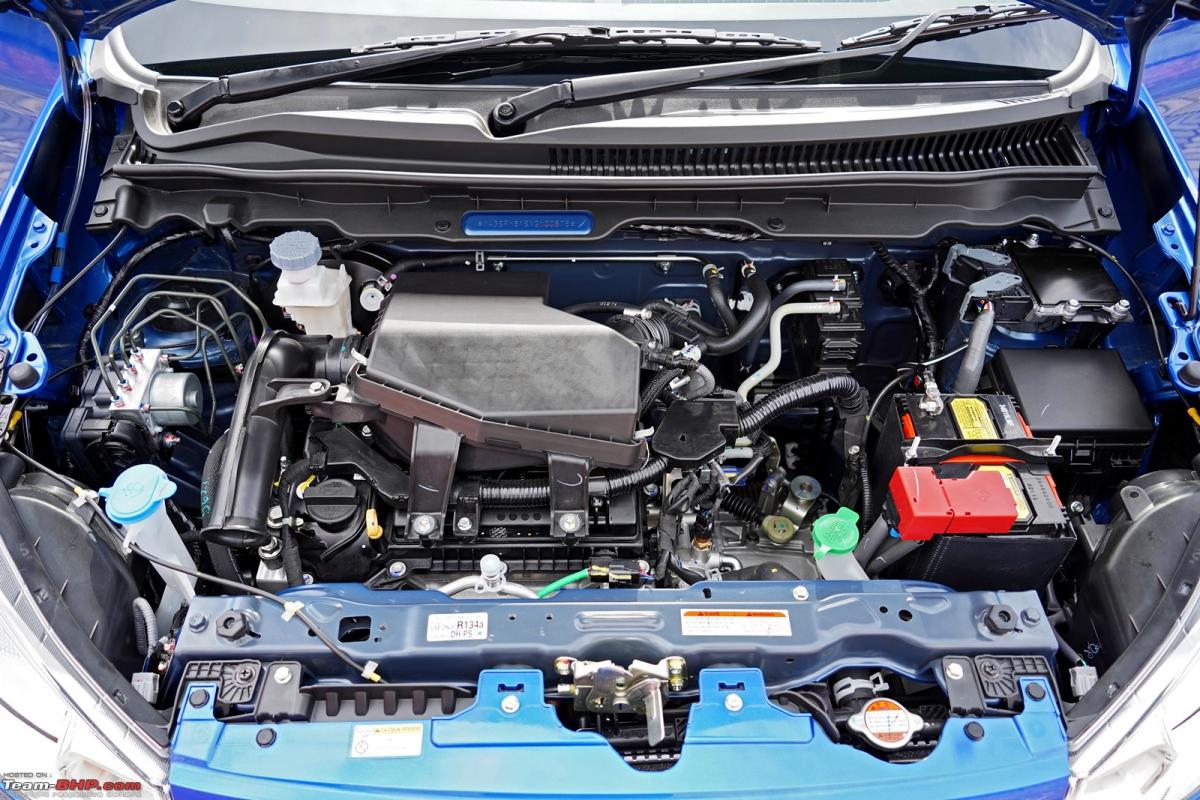
The K10C motor features two notable additions – Dual Jet and Dual VVT. This means that there are two injectors (Dual Jet) per cylinder that spray fuel into the combustion chamber. Having two injectors leads to better atomisation and thereby cleaner combustion. The compression ratio has also gone up from 11 in the K10B to 11.5 in the K10C. VVT or variable valve timing adjusts the valve timing to increase fuel efficiency and in a 'dual' VVT system, both intake and exhaust valves are adjusted to maximise fuel efficiency and performance.
Crank the engine and you immediately realise that this is an entry-level car. Typical of 3-cylinder units, there is a little cabin shake on cranking, while mild vibrations are felt at idle. Release the light clutch and the Alto K10 rolls off from a standstill with ease. It can easily move away from 0 km/h in second gear too with light accelerator inputs. Driveability is excellent and the light kerb weight makes things easy for this little 1.0. The motor feels very tractable in the city and it’s got a practical state of tune. The healthy low-end & perfect gearing means you do not have to downshift too often. Driving around in the city won’t be much of an issue for this small hatchback. In fact, it feels very much at home. The only fly in the ointment is a light, but very perceptible judder felt near idling rpms, especially pronounced in 2nd gear. This was present in the AMT variant as well and is likely to be the result of some aggressive tuning for fuel efficiency.
Out on the open road, the Alto K10's power-to-weight ratio is enough for it to keep up with hatchbacks from a segment above. On the expressway, you'll enjoy redlining this car all the way to 83 km/h in second gear and 120 km/h in 3rd gear. Overtaking is easy & fuss-free. The engine gets vocal at higher revs and not everyone is going to enjoy its audio track. Sadly, the grip levels just can't keep up with the engine and thus, it is best to cruise at speeds of 90-100 km/h in 5th gear.
For quick overtaking manoeuvres, while at cruising speeds, you will have to shift down to 3rd gear as there’s not much progress when you floor the A-pedal in 4th gear. The tall 3rd gear and occasional downshifts to 2nd would take care of your pedal-to-metal driving when on twisty roads.
The clutch is nice and light to operate, with just the right travel length. The 5-speed gearbox could have done with shorter throws. While it is light and slots accurately, it feels a bit rubbery
Noise, Vibration & Harshness (NVH)
The NVH package is cheap & basic. The Alto does alright at city speeds. But as the revs climb, you’ll hear that 3-cylinder thrum that all of us are familiar with since the Maruti 800 days. It is also louder in the Alto than other Marutis with the same engine. Reason = poorer insulation. At 100 km/h, road & wind noise are high. What’s worse, while driving over broken roads, you’ll clearly hear pebbles hitting the inside of the wheel arches (as there is partial / no cladding). Even the sound of rainwater splashing against the wheel wells is heard inside the cabin! Maruti could surely improve the NVH.
Mileage & Fuel Economy
Maruti has done a lot of things to maximise fuel economy. The ARAI-certified fuel economy of the Alto K10 MT is 24.39 km/l. With the AMT gearbox, the fuel economy is even higher at 24.9 km/l. Owners should have no reason to complain in the real world either - we were seeing average MID figures close to 20 km/l despite some heavy foot driving.
That said, the figures are lesser than the Celerio, which debuted with the same motor despite it being a heavier car with much better tyres. We attribute the difference to the idle start-stop system in the Celerio that shuts off the engine while idling, which also adds to the fuel efficiency.
Driving the Alto K10 1.0L Petrol AMT
The 2022 Alto K10 gets the latest generation Magneti Marelli-sourced AMT unit, which is available in the VXi and VXi+ variants.
The AMT mechanism is a simple bolt-on job and uses the K10 MT's existing gearbox. It’s pretty straightforward in the way it works. Mechanically, the AMT gearbox is identical to the K10’s manual transmission. What's different is how the clutch is operated and how the gears are shifted. In the MT, the driver is responsible for these tasks. With the AMT, hydraulic actuators located in the engine bay operate the clutch and shift gears. There's no clutch pedal, and zero driver input is required for gearshifts, making it exactly like a conventional automatic to drive. Simply put, the mechanical functions of operating the clutch and gear lever have moved from inside the cabin to the engine bay. To know more about AMTs & how they work, click here.
Starting the engine must be done with the gear lever in neutral. You have to press the brake pedal as well, or else the engine won't fire up. There's no 'P' (park) mode or gear unlock button like in a conventional AT. Once fired up, slide the gear lever to 'D' (drive) to get going. As you release the brake, the car will move forward without any accelerator input. However, it doesn't move too fast and will crawl at 6-7 km/h, without any accelerator input. When you press the accelerator, you'll notice that the throttle response is quite immediate. It's exactly like a pure manual in this respect.
In the city traffic is where the AMT truly shines and brings the most benefits. There's no clutch pedal and there's no requirement for the driver to repeatedly shift between Neutral-1st-2nd either. In crawling bumper-to-bumper traffic, you don't need to give any accelerator input. Just release the brake, and the car crawls forward. The start-off is extremely smooth. Budget car owners will love the fact that their left leg is completely relaxed. The tricky part with the AMT in city driving though is parking in tight spots. Unlike a conventional AT where it's possible to ease the car forward very gradually, the AMT is more of an "on or off" solution, as it tries its best not to slip the clutch more than required. This results in a more eager movement, which can be a bit tricky when getting in & out of tight parking spaces.
Gear-shifting quality is a universal sore point for automated manual transmissions. The K10's AMT unit, which is the improved version of the previous generation, is actually very good. In fact, it seems like Maruti has finally caught up with Hyundai’s smooth-shifting AMT. With a light foot on the accelerator, the gearshifts are barely noticeable. First-time automatic drivers won't have any complaints with the AMT. It’s only when you are driving with a heavy foot that the shifts are noticeable in the form of the typical head-nod.
People who are used to driving AMT cars will like this unit for sure. One of the ways to make your drive even smoother is to let off the accelerator at intervals, and the AMT will seize that opportunity to upshift. E.g. When going from 0-40 km/h, let off the accelerator very slightly at 10, 20 and 30 km/h, and the AMT will take each one of those opportunities to move up a gear - almost like you told it to! Shift quality gets better between higher gears and is virtually seamless when going downhill. The AMT unit is smooth even while downshifting. There's absolutely no noise or clunking when the gears shift.
Fuel efficiency is without a doubt what the AMT has been tuned for. This means the transmission is very eager to upshift and before you know it, you will be cruising along in 5th gear at 50 km/h. Even in crawling traffic, the AMT will upshift to 2nd gear at fairly low speeds. When the rpms drop, the transmission will downshift to a lower gear. Interestingly, if left without accelerator inputs in rolling traffic conditions - the car will slowly move in 2nd gear at 14 km/h, and the transmission will shift down to first only when the brakes are applied. The current gear indicator on the MID keeps you in the loop as to which gear is engaged. It's quite a novelty and will be appreciated by prospective and existing owners of the Alto K10 AMT.
The engine gives out a nice blip on kick-down and doesn't hesitate to drop down two gears at a time (e.g. 5th to 3rd). With a heavy foot on the accelerator, the AMT holds a gear all the way to the end of the rpm range before upshifting. The driver also has an option to use 'manual mode' to prevent premature upshifts while overtaking on highways.
Manual mode has other advantages as well, especially for the more enthusiastic drivers who want a higher degree of control. Like other hatchbacks with AMTs, the K10 offers a Tiptronic-like manual mode. Towards the right of the MID gear indicator, there is a small alphabet readout: 'M' for Manual & 'D' for Drive, indicating the mode that you are currently in. In manual mode, the AMT will still not upshift automatically unless you reach the end of the rpm range. Conversely, if the rpm drops too low, the AMT will downshift to prevent the motor from stalling. If you try to upshift at too low an rpm or downshift at too high an rpm, the AMT will ignore your instructions and flash the gear indicator in protest. It's always a good idea to switch to manual mode before your favourite ghat section because it prevents sudden & unsettling gear changes mid-corner. An advantage of manual mode is that you can increase the amount of engine braking when going downhill. It's quite effective, although not as aggressive as in a pure MT. We recommend shifting to manual mode before overtaking when you need engine braking and of course, the times that you are in the mood for some fun.
Hill starts require you to use the correct procedure in order to minimize rollback. When starting off on a hill, switching your foot immediately from the brake to accelerator will result in the car rolling back... before it engages the clutch and moves forward. On a steep hill, the car can roll back as much as 3 feet before moving forward. It's dangerous, and also bad for the clutch in terms of wear & tear and overheating. Thus, it's best to use the parking brake when starting off on an incline. This results in only an inch or two of rollback and a very gradual start-off. A "hill-hold" function would have been a neat addition, especially considering the same is already available in the S-Presso.
I'd also like to add that the AMT manages the clutch & gearbox a lot better than sub-par drivers out there. There's no doubt that it is more talented than a below-average driver in choosing when to shift, how to shift and what gear to drive in.
Suspension
Ride Comfort
The Alto K10 comes with a MacPherson strut suspension at the front and a torsion beam with coil springs at the rear. The overall setup feels very basic, with a soft edge to the setup. For an entry-level hatchback, the car remains quite comfortable over rough sections at city speeds. On the highways - smaller patches are absorbed, but not in a confidence-inspiring way - because there is some roll and side-to-side wallow induced when going over the broken stuff. You will feel that the Alto is out of its comfort zone! Larger potholes register themselves sharply in the cabin, and it is possible to bottom out the suspension if you do not slow down. The suspension isn't silent in its operation either, and you can hear it work on a patch of bad road.
Handling & Dynamics
In a nutshell, the car is awesome in the city - its natural habitat. It’s narrow width + tall seating + good low end + peppy engine make it easy to dart in and out of traffic. As expected in such a small car, the turning radius is also small at just 4.5 m.
On the highway, it is mediocre and feels skittish. The motor has adequate pep to keep up with bigger cars on the highway, but the Alto K10 simply isn't planted at speeds above 100 km/h. We strongly recommend owners maintain an extremely safe & conservative driving style over inter-city commutes. Keep it at 100 km/h or below.
Body roll is present and this is not a car you'd like to corner hard in. The car's 13" rims are shod with 145/80 section JK Ultima-Neo tyres. Chosen for fuel-efficiency, these tyres are too thin for fast cornering - even the previous generation car had 155 section tyres! Woefully inadequate for the power on offer, and you have to be very careful while cornering, especially in wet situations.
Steering
The electric power steering in the Alto K10 is one-finger light at parking and city speeds. This makes it a very easy car to drive in urban surroundings. However, some might feel the steering is too light and vague in the center and you get no feedback at all. It’s pretty much dead like a video game steering. The mass market will like it though. At higher speeds, the steering does weigh up, but the complete lack of feel or feedback can be unnerving. Like the steering in most Maruti cars, there is no strong return to center action. Leave the steering at a slight angle while driving and you will keep on going in that direction. You have to manually straighten it.
Braking
The Alto K10 is equipped with disc brakes at the front and drum brakes at the rear. The brakes perform well and as you would expect without any drama. But there is only so much grip that can be provided by 145 section tyres, before ABS kicks in.
Niggles & Problems
The previous generation Alto K10 had quite a few issues with the AMT unit. Hopefully, the newer generation Magneti Marelli AMT unit isn’t riddled with problems. Apart from this, Maruti has a wide service network and part availability is never much of an issue. So ownership experiences should be satisfactory. That being said, get the extended warranty without giving it a second thought.
Continue reading the discussion on the Maruti Alto K10 on our forum.
Pages



